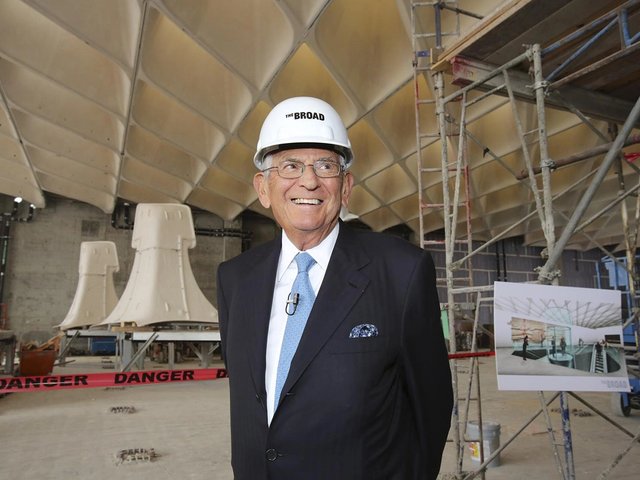Eli Broad, the billionaire art collector and philanthropist, has pledged $60m to the Los Angeles County Museum of Art (LACMA) to create a new building for art since 1945 and an endowment for acquisitions of contemporary art.
The cash gift, the largest in the museum’s history, will cover “every penny” of a $50m wing that will be named after Broad and designed by an architect of his choosing, subject to board approval. Details are yet to be ironed out, but the rough outlines call for a 70,000-square-foot structure facing Wilshire Boulevard and bridging the gap between LACMA’s main campus and its under-developed annexe known as LACMA West.
That land is currently bisected by Ogden Street, which LACMA president and director Andrea Rich says will be closed. The new wing will house LACMA’s postwar permanent collection, along with some 200 complementary works from Broad’s large personal collection, as well as works newly acquired through his $10m fund for contemporary art. Broad announced the gift—the biggest he has ever made—at his 70th birthday celebration in June.
The windfall gets LACMA moving again after the recent cancellation of a dramatic raze-and-build expansion plan by Dutch architect Rem Koolhaas.
Broad, a museum trustee since 1995, had promised $50m toward that $300m scheme, but the museum failed to find other major donors to get the project off the ground.
The Koolhaas plan is scrapped, according to Rich. “I don’t see any real potential for it,” she says, adding, “There was real excitement, but the times were such that it wasn’t do-able. We’re going back to the original plan,” she says, which was to reconfigure the museum’s existing campus—a cluster of disparate buildings erected over the past 30 years.
The museum retained five architects, four of whom proposed interlinking the main group of buildings with LACMA West. Only Koolhaas opted to tear down the museum and start from scratch. His plan generated considerable enthusiasm among the trustees and staff, but as Rich points out: “It had to be done all at one time.”
By contrast, the Broad plan “will occur in logical phases, which is nice at this time in the economy. It will happen in an evolutionary way that will be a lot more stable. It’s not one of those really risky things that jeopardises the whole institution.”
LACMA recently reorganised its 100,000-work encyclopedic collection into “centres” for the arts of Europe, Asia, the Americas, and Modern and contemporary art. (The restructuring closely resembles one undertaken several years ago by Boston Museum of Fine Arts director Malcolm Rogers.)
The Broad plan will enable the physical configuration to reflect this museum-within-a-museum scheme. “Our permanent collection and its exhibit will become much more coherent than it is now,” says Rich. When postwar art moves into the Broad wing, the 25,000 square-feet it frees up in the Anderson Building will allow that wing to become home to the Art of the Americas. Chinese and Islamic art will shift from the Ahmanson Building into the Hammer Building, alongside the Japanese Pavilion. And the Ahmanson wing would become a centre for European and Modern art. LACMA West, a former May department store building, will house offices, space for new media, children’s programming, a research centre, and other programmes.
All this shuffling around will be costly, and Broad intends to lead a $100m campaign to refurbish the existing campus and increase the endowment, which currently stands at around $80m. With a fortune estimated to stand at around $5bn, Broad is the city’s preeminent philanthropist. His recent gifts include $20m for an art centre at UCLA and another $23m for a biology building at Caltech. His made his fortune as founder of a tract-home building company and of SunAmerica, a financial services company that sold for $18bn in 1999.


